When I was little, my mother had all of these books from her childhood by an author named Marguerite Henry. The books were all in hardback, with gorgeous color illustrations, and they were all dramatized but ostensibly true stories about horses. I was in one of those phases at the time and I must have read all of them cover-to-cover a dozen times each. A number of them were about a family on the island of Chincoteague on the American east coast, but there was one about a boy in Italy and a horse that he rescued, trained, and raced in the Palio in Siena. The book was called Gaudenzia--the name of the horse, which one character translates as “the joy of living”--and because of it, I became obsessed with the Palio for a good few years, in spite of how dangerous it was made out to be. I would play make-believe with props made hastily from whatever objects and art supplies I could find lying around and run around the yard, pretending that I was racing in the Palio.
The obsession faded after not too long, but you know, that sort of childhood love for a thing or a place never goes away. Even if I have not read that book in probably ten or twelve years, I remember the story in glimpses, in fragments of prose and mental images. Ever since reading it, I have secretly wished that I could see the place where it is held and experience it first-hand.
But before we get to that, I'll roughly follow our guided tour and show you a few other things first.
Siena is very much a Tuscan city; the streets are narrow, and generally stone rather than cement pavement, with no real delineation between sidewalk and drivable surface. A defining feature of Siena is its hills; the city is built over three of them, with prominent city features placed on each one. When walking through Siena, you'll go up and down, up and down, on steep terrain with abrupt changes in inclination.
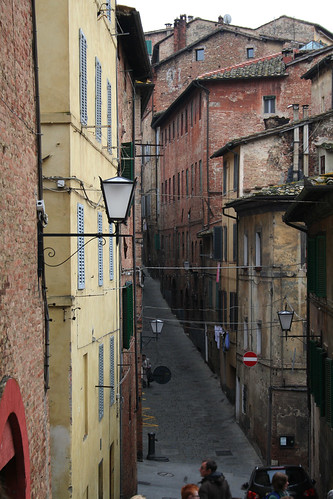
The dominant architectural style is medieval; there is lots of old stone and terracotta brick. Some areas have an almost Roman feeling to them.
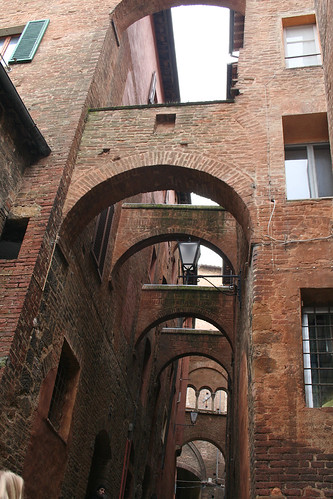
Our first stop on the tour was the Church of San Domenico, important to the Sienese because it was built in honor of St. Catherine, the patron saint of Siena and one of the two patron saints of Italy (along with St. Francis of Assisi). The story goes that Catherine, who had entered the public eye by traveling throughout Italy to help the poor and the ill and to advocate for clergical reform, went to Avignon (at the time, the seat of the Papacy) to ask the Pope to return to Rome. Less than a year later, her request was granted, and Pope Gregory XI moved to Italy. She died and is buried in Rome, but her skull and her thumb are preserved as relics in San Domenico.

There were no photographs allowed inside the church, though some members of our group were taking photos anyway. Let me take this moment to say that it really frustrates me when people do not respect the wishes or regulations at historical sites. Regardless of one's religious belief, I think it's important to at least give respect to the people who live in, worship at, and take care of these places, and above all, to never use your flash at historical or artistic sites, EVER. I could rant forever on this subject, but I will spare you.
Our next stop was the Duomo of Siena, formally the Cathedral of Santa Maria Assunta.
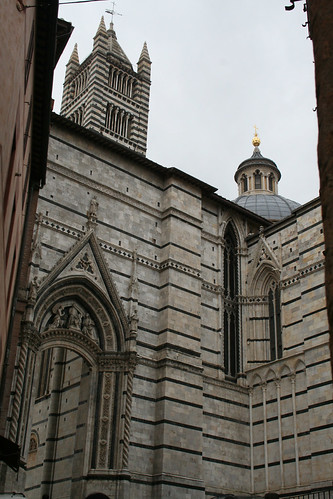
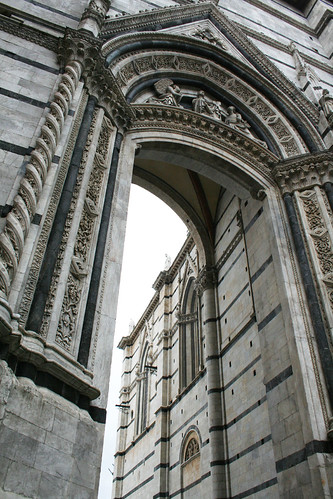
Constructed in the 13th century but including works from the Renaissance and additional chapels and structures from even later. As such, this Duomo is unusual among Italian churches in that it incorporates four architectural styles: Romanesque, Gothic, Renaissance, and Baroque.

The black and white marble is all from Siena (and other colors and varieties of local marble can be found inside, mostly in floor mosaics). Black and white, the colors of Siena, are said to represent the colors of the horses owned by the city's founding brothers, Senius and Aschius.
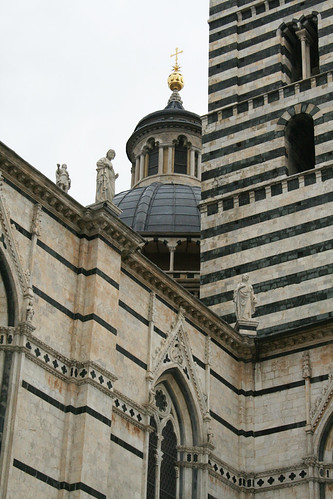
The façade is distinctly Gothic, and in fact reminiscent of the Duomo of Milan.
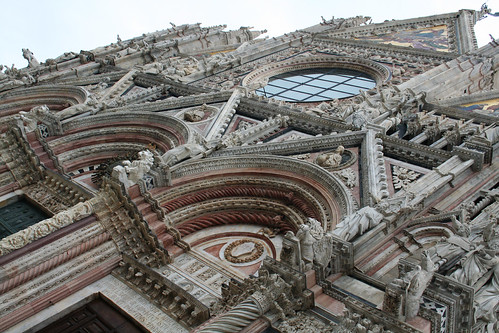
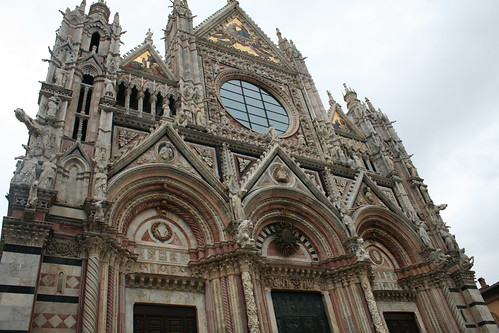
The interior is rich with frescoes and statues, and of course, the black and white stripes.
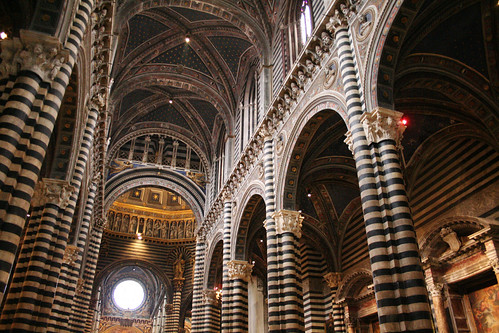
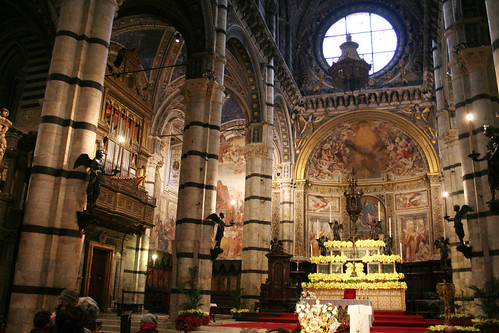
The Duomo has a library that was, until recently, closed off from the public and kept dark. As such, the frescoes on its walls (our guide attributed them to Rafael himself, but Wikipedia says differently—I shall leave it to you to decide!) are preserved in astounding color.
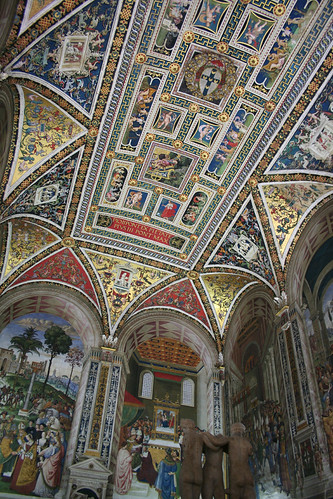
After leaving the Duomo, our guide took us at last to Piazza del Campo, where the Palio is held twice a year (once in July, once in August).
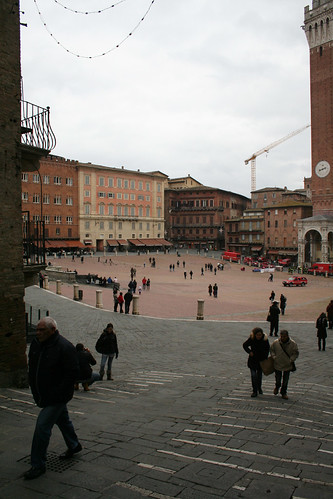
It is a surprisingly small space for a horse race! In fact, the race itself takes only a little over a minute.
The race represents a traditional rivalry between the seventeen districts, or contrade, that make up the residential sectors of the city. Each contrada has a mascot and a distinct identity. If you are born in a contrada, you belong to it for life, no matter where you may move. In each Palio, ten of the seventeen contrade contribute a horse and a jockey; the jockeys ride bareback, and use their whips as much to disturb other jockeys and horses as to encourage their own. Preventing one's rival from winning is as much a part of the sport as aiming to win oneself, and a surprising amount of physical interference is permissible. It is not uncommon for jockeys to fall (or be pushed) off, though it is important to note that a horse can win the race with or without its rider.
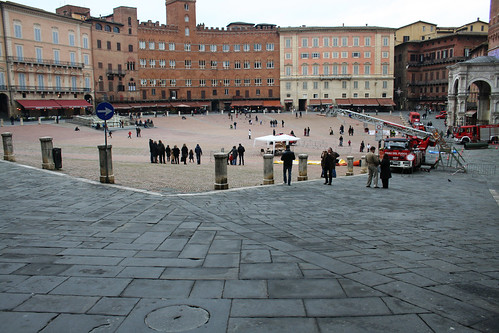
Standing in the Piazza del Campo was certainly one of the top ten most amazing moments of this trip. (Also among the top ten were: the tower in Lucca, my first cappuccino, standing in the Colosseum, the bistecca fiorentina that I had for dinner last night.)
After Siena, we went to a wine-tasting at a small Chianti vineyard called Sant'Appiano, which ages its wines in oak barrels in a traditional underground cellar that is more a cave than a constructed space. It's beautiful.

The wines (and the olive oil) were excellent.

Spectacular, Tracy! I just pulled "Gaudenzia, Pride of the Palio" from my bookshelf -- I can see the buildings from your photographs in the illustrations. How wonderful.
ReplyDeleteStill enjoying your blog, and it's also interesting seeing your posts about the places I never went to (like Milano for one). Siena looks amazing, and your fondness for it I'm sure made going there even more meaningful! Chianti is nice wine, I love Chianti Classico as well.
ReplyDeleteRegarding a previous post of yours, I might actually be interested in buying some of your prints if you still decide to do that!